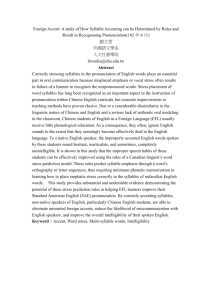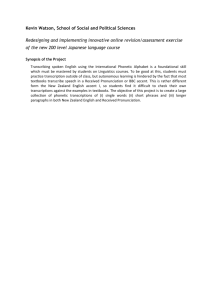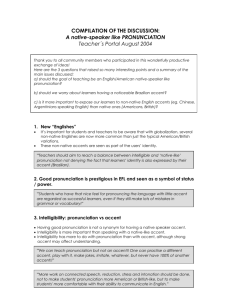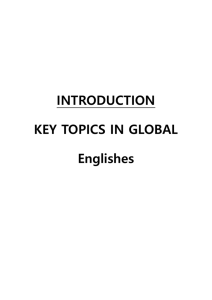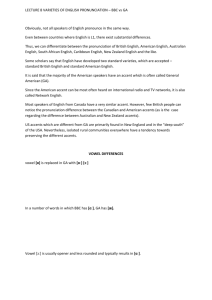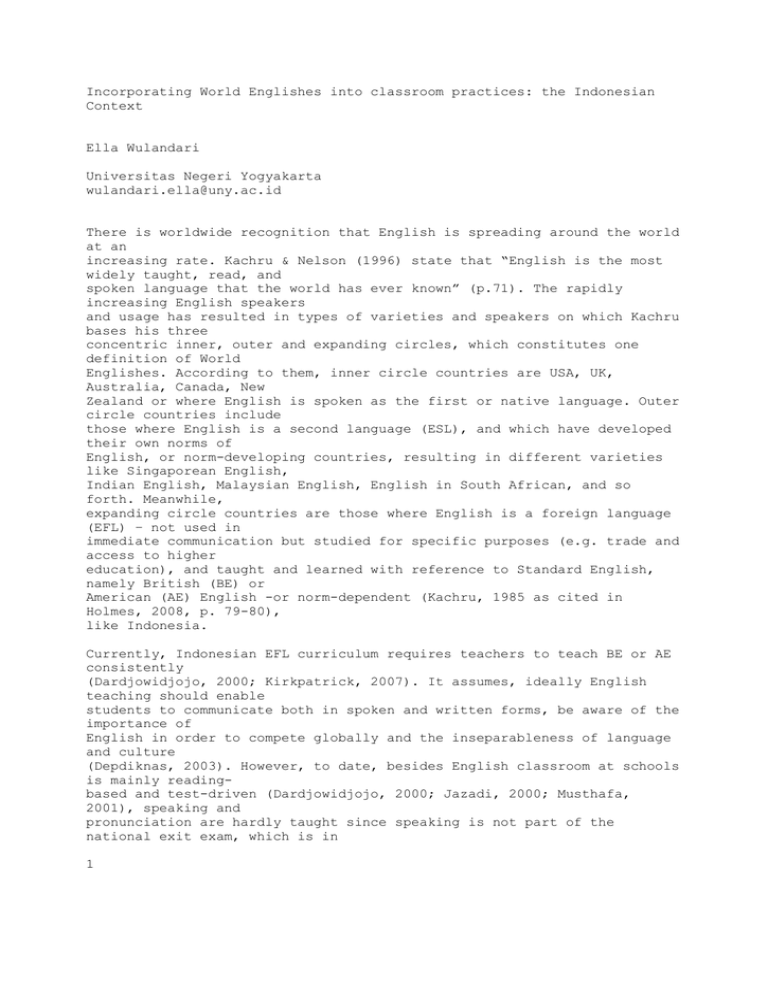
Incorporating World Englishes into classroom practices: the Indonesian
Context
Ella Wulandari
Universitas Negeri Yogyakarta
wulandari.ella@uny.ac.id
There is worldwide recognition that English is spreading around the world
at an
increasing rate. Kachru & Nelson (1996) state that “English is the most
widely taught, read, and
spoken language that the world has ever known” (p.71). The rapidly
increasing English speakers
and usage has resulted in types of varieties and speakers on which Kachru
bases his three
concentric inner, outer and expanding circles, which constitutes one
definition of World
Englishes. According to them, inner circle countries are USA, UK,
Australia, Canada, New
Zealand or where English is spoken as the first or native language. Outer
circle countries include
those where English is a second language (ESL), and which have developed
their own norms of
English, or norm-developing countries, resulting in different varieties
like Singaporean English,
Indian English, Malaysian English, English in South African, and so
forth. Meanwhile,
expanding circle countries are those where English is a foreign language
(EFL) – not used in
immediate communication but studied for specific purposes (e.g. trade and
access to higher
education), and taught and learned with reference to Standard English,
namely British (BE) or
American (AE) English -or norm-dependent (Kachru, 1985 as cited in
Holmes, 2008, p. 79-80),
like Indonesia.
Currently, Indonesian EFL curriculum requires teachers to teach BE or AE
consistently
(Dardjowidjojo, 2000; Kirkpatrick, 2007). It assumes, ideally English
teaching should enable
students to communicate both in spoken and written forms, be aware of the
importance of
English in order to compete globally and the inseparableness of language
and culture
(Depdiknas, 2003). However, to date, besides English classroom at schools
is mainly readingbased and test-driven (Dardjowidjojo, 2000; Jazadi, 2000; Musthafa,
2001), speaking and
pronunciation are hardly taught since speaking is not part of the
national exit exam, which is in
1
contrast with the curriculum’s first objective. If speaking were to be
taught, it is unlikely that
teachers in Indonesia would be able to teach BE and/or AE accents.
Furthermore, in my view,
the dominance of English as the lingua franca (ELF) in South East Asia
(SEA) (Kirkpatrick &
Deterding, 2006; Kirkpatrick, 2006) with all the different accents with
which it is spoken makes
the curriculum’s imposition on BE or AE varieties both unachievable and
unnecessary. This
paper therefore argues that raising awareness of and aiming mutual
intelligibility toward World
Englishes should be part of English language teaching (ELT) in Indonesia,
while persevering the
teaching of Standard English in Indonesian classrooms. It further
discusses how such attempt is
brought into practice with regards to the input, process and output
aspects of English teaching
and learning, so as to produce proficient but not native-sounding English
users.
WEs and ELF
There are a number of terms associated with different uses of English
around the world,
such “English as an International Language”, ‘World Englishes’, ‘World
English’ (in singular),
‘International English(es)’, ‘World Standard Spoken English’, ‘English as
a Lingua Franca
(ELF)’ and so forth (Acar, 2007; Matsuda, 2003). For the purpose of the
discussion, World
Englishes (WEs) in this paper is defined in conjunction with Kachru’s
polycentric approach, as
previously explained, and is differentiated from ELF, as suggested by
Jenkins (2006) or
Seidhover (2001), and investigated by Kirkpatrick & Deterding, (2006),
Kirkpatrick, (2006),
Sifakis (2009), Pickering (2006), or Elder & Davies (2006).
Both WEs and ELF seem to illustrate the different contexts and uses of
English in the
world. While WEs classifies the circles more globally, ELF appears to
focus on the outer and
2
expanding circles, where interaction among non-native speakers (NNSs) of
English is arguably
more dominant (Pickering, 2006). There has also been a growing debate
about whether ELF is “a
well-established variety of English with its own norms and regularities,
similar in kind if not
degree to so-called nativised varieties” (Prodromou, 2007, p.109).
Whether it sufficiently
provides norms of standard written ELF, by which it can be fully claimed
to be an emergent or
emerging variety of English has also been questioned by Maley (2009) for
example, who argues
that it seems to focus only on the spoken language. Still, this paper
does not intend to discuss
whether ELF is in existence as proposed by its proponents or whether it
is widely accepted by
many linguists. It does, however, agree with the fact that English has
shifted from mainly used to
communicate with its native speakers (NS) to a means of communication
also among NNSs of
English, or a lingua franca, makes it necessary to reconsider imposition
of varieties spoken only
by English NSs including BE or AE, for several reasons.
First, it is unachievable and unnecessary to expect ELT to be able to
make all students
become English NNSs, who are sounding like native, though as in Japan
(Butler, 2007; Matsuda,
ibid), Cambodia (Moore & Bounchan, 2010), and Greece (Sifakis, 2009),
Indonesian teachers
and students, to date, regard native varieties and accents as the most
correct and thus aspire to
them. Compared to the large number of students in Indonesia, there seems
to be insufficient
teachers skilled in producing pronunciation consistent with these
accents. Taught by Indonesian
teachers, few of whom, had experienced living or studying in inner circle
countries, most
practicing teachers were insufficiently exposed to nor acquiring either
accent. With lacking
teachers trained in BE or AE accent, inflicting either accent is not
feasible.
Secondly, similar to Japanese (Matsuda, 2003), Indonesian students are
‘as likely to be
exposed to outer-and expanding-circle Englishes as they are to inner
Englishes’ (p.721).
3
Deterding & Kirkpatrick (ibid, p.392) particularly proposes an emerging
South-East Asian
Englishes due to the accelerating number of various English speakers in
the region. Accordingly,
learning to speak inner circle accent(s) seems unnecessary for Indonesian
students as they will
likely encounter speakers from Asia, and not all of them learn English to
go to English speaking
countries. Further, restricted to BE/AE accent exposures in classroom
will even make them
unprepared when confronted with a variety of accents other than the
one(s), be they Asian,
African or European, and therefore cannot communicate in English
effectively.
However, Timmis (2000 cited in Maley, 2009, p.194) asserts that not
teaching standard
of English aspired by students is as inappropriate as imposing nativespeaker varieties. Hence,
according to Acar (2007), Maley (2009) and Matsuda (2003), what is more
important is how
teachers can teach a standard variety of English to satisfy curricular
and examination conditions,
while equipping students with (accommodation, repair, clarification)
verbal strategies to enable
them cope with a variety of accents – either native or non-native. Maley
also argues that in
reality teachers are teaching what they are able to teach – what they
have learned. He says that,
“It is also true that teachers teach what they are able to teach. For the
most part, they do
not completely control their own accents or even their own syntax, which
will be heavily
influenced by their mother-tongue speech community. Though they may
assert that they
are teaching are teaching “British” or “American English”, what they are
actually doing
is attempting to teach a standard variety with whatever accent or
grammatical form of
English they happen to have, be it Chinese, Brazilian, Spanish, Italian,
or whatever. And
this is perfectly acceptable. Indeed, it is difficult to see what else
they might be doing”
(p.195).
Given this, it is suggested that Indonesian teachers should also be
allowed to teach
whatever accent they have, be it Indonesian, outer or expanding circle
one, while attempting to
teach either or both BE and AE. Acar (ibid, p.50) argues that considering
inner circle varieties as
a model for an expanding country, including Indonesia, does not
necessarily mean the students
4
(and teachers) should achieve native like proficiency. Native-sounding
pronunciation will be a
discouraging target since research shows that ‘very few learners are
capable of achieving a
native-like standard in all respects’ (Luoma, 2004, p.10). Luoma
continues,
“Communicative effectiveness, which is based on comprehensibility and
probably guided
by native speaker standards but defined in terms of realistic learner
achievement, is a
better standard for learner pronunciation”.
Supporting, Derwin and Munro (2005, p.384) claim that accented speech or
foreign
accent is a normal consequence of second language learning. English with
‘marked local flavour’
is unavoidably a product of aspiration toward a standard variety but
influenced with first
languages in the process. Aiming at comprehensibility, both teachers and
students will develop
more confidence to produce and be proficient users of English despite
their non-native accent
(Maley, 2009, p.196). This also raises positive attitude toward nonnative teachers, who often
suffer from less intelligent and professional perception resulting in
their reduced quality of
pronunciation and degree of confidence in using English (Medgyes, 1994;
Nelson, 1991;
Solomon, 1991; in Butler, ibid, pp. 734-736). Accordingly, while
endeavouring to reach native
pronunciation accuracy and acknowledging other non-native accents,
teaching English in
Indonesia with local but comprehensible accent should be justifiable.
Thus, it is more important
to equip learners with accommodation skills that allow them to get their
messages across through
achieving mutual intelligibility, in order to communicate successfully
with either NSs or NNSs
of English.
Aiming mutual intelligibility
Maley (2009) argues that teachers can hardly teach all English varieties
in the world but
how to cope with those differences, “through developing a respect for
difference and a positive
attitude to accommodation” (p.197). It is therefore the skills of
accommodation which are needed
5
to be taught to allow learners achieve mutual intelligibility when
communicating either with NSs
or NNSs. Citing Canagarajah, Maley highlights that studies in speech
accommodation suggests
that speakers “make mutual modifications in their speech to facilitate
intelligibility”, and that
conversation analysis shows that speakers “skillfully employ strategies
of repair, clarification
and paralinguistic interpretation (that includes gestures, tone and other
cues) to negotiate
differences” (Cited in Rubdy & Saraceni, 2006a, pp. 208 and 209, in
Maley, 2009).
Within discussions of Wes, Smith and Nelson’s (1985, cited in Deterding &
Kirkpatrick,
2006; Pickering, 2006) definition of intelligibility has been widely
accepted. Intelligibility
comprises three levels including “word recognition, utterance
comprehension in a given context,
and interpretation of speakers’ intention or meaning behind utterance.
Since the nature of
interaction between NS-NNS and NNS-NNS interactions is different, various
factors have to be
first identified to aim mutual intelligibility particularly in the latter
type of interaction. Pickering,
with focus on ELF, suggests some variables affecting intelligibility and
comprehensibility in
those two kinds of interactions. It should be remembered, however, that
citing his ideas does not
necessarily mean that this paper provides support for the existence of
ELF as a variety, but is
expected to help in finding ways to tackle with those factors, i.e.
speakers and listeners factors.
Phonology and the effects of accentedness are factors influenced by
speakers in NS-NNS
interaction (Pickering, 2006), while pronunciation is the greatest
problem among ELF speakers
(Jenkins, 2002, cited in Pickering, 2006). Listener aptitude is the next
factor crucial in aiming at
intelligibility in NS-NNS interaction. Pickering explains that “a
listener who expects to
understand a speaker will be more likely to find that speaker
comprehensible that one who does
not” (p. 226). Other related variables on listener part include
“familiarity with a particular speech
6
event, topic, or specific interlocutor, listener specific factors such as
level of tiredness or
situation specific factors such as environmental noise”.
The first factor relates to phonology, pronunciation and accentedness can
be overcome by
giving more emphasizes on teaching pronunciation in English classroom in
Indonesia. The
teaching of pronunciation can be based on either BE or AE accent, yet
without imposing the
native-like pronunciation as target. Instead, intelligibility should be a
standard of measurement,
aiming at understanding and conveying the intended messages across, by
both interlocutors. To
compensate with different varieties, it is advisable to expose learners
with different accents or
varieties of English, particularly those of NNSs who are from
neighbouring countries. Exposures
to English BE, AE or other accents can be made available through
particular methods of teaching
and the use of technology.
Zhang (2005) carried out a conversation class where native-speakers and
learners
communicate to each other authentically in foreign language classroom. In
Japan, assistant
English teachers (AETs) are employed through Japan Exchange and Teaching
(JET) program to
enhance its teachers’ English proficiency (Matsuda, 2003, p.720). Free
English learning websites
and online dictionary with pronunciation model should also prove useful.
Meanwhile,
introducing students to non-native accents will increase their confidence
to speak ‘accented’
English and ability in recognizing and comprehending different accented
Englishes (Omori,
2007). Omori further finds that training in familiarizing with accented
English (English spoken
by NNSs) is proven effective to help increase intelligibility on part of
listeners. Utilizing
multimedia and electronic communication, Maley (2009, p. 197) suggests
using songs, E-mail,
websites, blogging, texting, DVDs, TV and internet sources to provide
exposures to various
accents. Having a video conference or live chat with speakers in inner,
outer and expanding
7
circle countries can be another solution. Yet, encouraging and
facilitating Indonesian teachers
whose oral proficiency is high to develop their own audio materials
modelling accurate and
comprehensible local accent(s), to me, are more likely to build
Indonesian teachers and students’
confidence in their accent while purporting native’s pronunciation
accuracy.
Factors related to listeners can further be coped with providing learners
with
accommodation skills including repair and clarification strategies, and
abilities in interpreting
paralinguistic aspects of communication (gestures, tones, conversational
cues), and knowledge of
speech events or topic. Repair strategies Those skills should inevitably
be taught in class directly
or indirectly. Since these factors are likely to occur in spoken
interaction, teaching verbal skills
of English is thus necessary. It should not merely provide learners with
opportunities to create
and perform dialogues with peers or listen to others’ speech but also
provide authentic samples
of speech events happening in meaningful contexts. Input given in English
classes must be in
context or taken from a speech event, either written or spoken. When it
is written, teachers
should provide discussion on how such event can be carried out in spoken
medium. When
discussing speech events, teachers are also to expose specific utterances
or expressions
commonly used in given situations, and certainly their meaning in
relation to specific cultural
values or norms of a given society exhibited in the samples of events.
Ultimately, learners are
given opportunities to experience interacting in such events in classroom
setting. Since input is
what EFL settings lack of, providing meaningful but comprehensible input
is of great
importance. The alternatives suggested above should also be fruitful to
deal with input scarcity.
When input is already made available, shifting orientation from product
to process-based
approach is advisable (Serdiukov & Tamopolsky, 1999). Regardless methods
of teaching being
used, ELT should be directed to provide learners with opportunities to
experience with the target
8
language. Learners should certainly be engaged with not only forms but
also meaning, where
pragmatics might have to come into play. Since this approach is expected
to be in conjunction
with any methods or techniques of teaching, it is thus the mindset of
teachers, which plays a
great role in implementing such approach. In assessing the output or
outcome of learning, it is
advisable that teachers do not solely apply form accurateness standard.
Evidences of the use of
accommodation skills, and knowledge of different speech events should be
considered in
assessment, and incorrect or inappropriate class performances should be
referred to how far
learners have been well endowed with those skills and knowledge. In other
words, strategic
competence should come first over linguistic accuracy, in terms of
pronunciation or verbal
aspects of communication. In regards to pronunciation (and accent), Luoma
(2004, p.11)
proposes fitting accuracy and communicative effectiveness into a
criterion like ‘naturalness of
pronunciation’ if other criteria co-occur. Likewise, (Smith, 1992 in
Deterding and Kirkpatrick,
2007; Kachru and Nelson, 1996, pp. 93 – 4) encourages mutual
intelligibility that assesses ability
to recognize words, comprehend utterance and capture the meaning behind
the utterance.
In conclusion, due to different accents of speaking Standard English,
English teachers in
Indonesia encounters challenges related to the spread of uses of English
and its various varieties,
how to teach the varieties to enable learners to cope with them in real
communication, and
aiming mutual intelligibility through teaching accommodation skills and
knowledge of different
speech events. It is suggested that Indonesia should adopt ‘polycentric’
model – teaching English
referring to native accents while valuing teachers’ ‘local’ accents and
recognizing other nonnative
accents (Maley, 2009). Technology, conversation buddies, teacher
assistant program,
developing local-accent based materials are recommended to expose
students to a variety of
accents. The inputs should be made meaningful and comprehensible, through
which
9
accommodation skills (repair and clarification strategies) are taught.
The process of ELT is
recommended to adopt process-based approach where learners are provided
with opportunities to
experience the target language in classroom settings. The assessment
criteria should therefore
contain mutual intelligibility in terms of native pronunciation accuracy
and communicative
effectiveness – but not native-like accent.
10
REFERENCE
Acar, A. (2007. Standards and competence in English as an international
language pedagogy.
ASIAN EFL Journal, 9(4). Retrieved from http://www.asian-efl
journal.com/Dec_2007_aa.php
Butler, Y.G. (2007). How are nonnative-English-speaking teachers
perceived by young learners?
TESOL Quaterly, 41(4), 731-755.
Dardjowidjojo, S. (2000). English teaching in Indonesia. English
Australia Journal, 18 (1), 22
30.
DEPDIKNAS. (2003). Kurikulum 2004. Standar kompetensi mata pelajaran
bahasa Inggris
Sekolah Menengah Atas dan Madrasah Aliyah. Jakarta: Author.
DEPDIKNAS. (2003). Kurikulum 2004. Standar kompetensi mata pelajaran
bahasa Inggris
Sekolah Menengah Pertama dan Madrasah Tsanawiyah. Jakarta: Author.
Derwing, T.M. & Munro, M.J. (2005). Second language accent and
pronunciation teaching: A
research-based approach. TESOL Quaterly, 39(3), 379-397.
Deterding, D. & Kirkpatrick, A. (2006). Emerging South-East Asian
Englishes and intelligibility.
World Englishes, 25(3/4), 391-409.
Elder, C. & Davies, A. (2006). Assessing English as a lingua franca.
Annual Review of Applied
Linguistics, 26, 282-301.
11
Hingli, I. & Linington, V. (2002). English proficiency test: The oral
component of a primary
school. In Richards, J.C. & Renandya, W.A. (Ed.), Methodology in language
teaching: An
anthology of current practice (pp.354-361). Cambridge, UK: CUP
Holmes, J. (2007). An introduction to sociolinguistics. (3rd ed.).
Harlow: Pearson Longman.
Hughes, A. (2003). Testing for language teachers (2nd Ed.). Cambridge,
UK: CUP
Jazadi, Iwan. (2000). Constraints and resources for applying
communicative approaches in
Indonesia. English Australia Journal, 18 (1), 31-40.
Jenkins, J. (2006). Current perspectives on teaching world Englishes and
English as a lingua
franca. TESOL Quaterly, 40(1), 157-178.
Kachru, B. B. & Nelson, C. L. (1996). World Englishes. In McKay, S. L., &
Hornberger, N. H.
(Ed..). Sociolinguistics and language teaching (pp. 71-102). Cambridge,
NY: CUP.
Kirkpatrick, A. (2007). Teaching English across cultures. What do English
language teachers
need to know to know how to teach English. English Australia Journal,
23(2), 20-36.
Luoma, S. (2004). Assessing speaking. Cambridge, UK: CUP
Maley, A. (2009). ELF: a teacher’s perspective. Language and
Intercultural Communication,
9(3), 187-200. doi.:10.1080/14708470902748848
Matsuda, A. (2003). Incorporating world Englishes in teaching English as
an international
language. TESOL Quaterly, 37(4), 719-729.
12
Moore, S. H. & Bounchan, S. (2010). Research reports. English in
Cambodia: changes and
challenges. World Englishes, 29(1), 114-126.
Musthafa, Bachrudin. (2001). Communicative language teaching in
Indonesia: Issues of
theoretical assumptions and challenges in the classroom practice. Journal
of Southeast
Asian Education, 2 (2), 1-9.
Omori, M. (2007). The effect of short-term exposure on familiarity with
accented English for
Japanese EFL learners. ASIAN EFL Journal, 9(3). Retrieved from
http://www.asian-efljournal.
com/Sept_2007_mo.php
Pickering, L. (2006). Current research on intelligibility in English as a
lingua franca. Annual
Review of Applied Linguistics, 26, 219-133.
Prodomoru, L. (2007). A reader responds to J. Jenkin’s “current
perspectives on teaching World
Englishes and English as a lingua franca. TESOL Quaterly, 41(2), 409-413.
Seidlhofer, B. (2001). Closing a conceptual gap: the case for a
description of English as a lingua
franca. International Journal of Applied Linguistics, 11(2), 133-158.
Serdiukov, P. & Tarnpolsky, O. (1999). EFL teacher’s professional
development: a concept, a
model, and tools. U.S. Department of Education, Office of Educational
Research and
Improvement, Educational Resources Information Centre (ERIC),
Sifakis, N. (2009). Challenges in teaching ELF in the periphery: the
Greek context. ELT Journal,
63(3), 230-237. doi:10.1093/elt/ccn057
13
Ur, P. (1996). A course in language teaching. Practice and theory.
Cambridge, UK: CUP
Zhang, Y. (2005). Introducing native speakers to the foreign language
classroom. Journal of the
Chinese Language Teachers Association, 40(3), 71-90.
14

